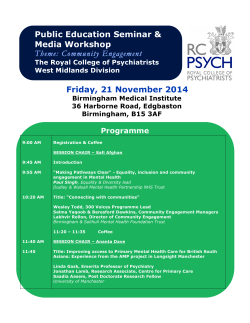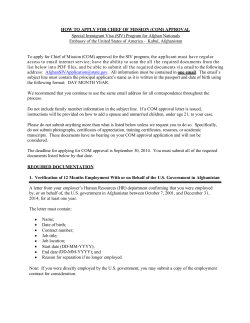
Seminar 2 - robertk.asia
Seminar 2 Evolution of the international intervention in Afghanistan, 2002-2014 Characteristics of the Bonn Process – It provided a roadmap conferring progressive legitimacy to the Afghan government and the post-Taliban political order – It mobilized the second-tier members of the old, pre-Taliban ruling elites (partial renewal), notably mujahideen and old entourage of the King –The ‘Light Footprint’ • UN and international community maintain a light, unobtrusive presence • Let the Afghans lead / Afghans in the Driver’s Seat • In as many fields as possible, Afghans take responsibility. Example: Loya Jirga – Attempt to enforce technocratic, non-political solutions What happened? Which light footprint? Who leads? In the driving seat of what? Operation Enduring Freedom • Warlords return to power • Contradictory Objectives between UN and Coalition objectives fail to bring peace and stability Observations about the ELJ The chance to amend the Bonn Agreement and make it more representative of the aspirations of the Afghan people was missed The Afghan government did not receive a mandate from its people, continuing its dependence on the international community The Afghan people became cynical towards the political process The new political elite understood that Western principles were flexible Start of the Iraq War • International attention shifts away from Afghanistan • A different, more military, less internationally consensual and more overtly nation-building type of intervention is attempted by the USA and its ‘Coalition of the Willing’, who invest much more heavily in Iraq than in Afghanistan • The emergence of AQ as a new type of enemy • The end of the UN’s aura of neutrality with the bombing of the UN offices in Baghdad 2003 Constitutional Process • Wrangling between French and US constitutional experts, to determine who will have most influence on crafting the Afghan constitution • However, in a lengthy and messy process, the Afghan commission members impose their own kind of constitution: based on sharia but with the guaranteeing of many individual rights; sweeping executive powers with few checks and balances; a parliament and provincial councils elected by SNTV. • Voter registration process very faulty, for lack of a census and a less-than ‘independent electoral commission’ – this will allow serious fraud in favor of the sitting president. • No credible candidates against Karzai • Nevertheless, the process energizes Afghan society and provides a democratic impulse – until the scale of the fraud becomes known. • The strong involvement of the UN and other international community members in the electoral organs backfires, as they are again seen as insufficient protection against fraud. Presidential Elections of 2004 What is the relation between elections and democracy? Parliamentary elections 2005 • Popular disillusionment with electoral and democratic processes increases, leading to less participation (< 50% of registered voters). • The Parliamentary elections hail the definitive return of the warlords and local power brokers, and of patron/client politics. • And signal the comeback of Taliban, whose insurgency is steadily gaining ground • The result of the elections: an extremely fragmented Parliament (SNTV) Transitional Justice and National Reconciliation 1. Establishment of the Afghan Independent Human Rights Commission in March 2002 a hopeful, good start. 2. The lack of proper documentation and mechanisms to deal with past war crimes becomes a major problem during the vetting process of parliamentary candidates in 2005. Very few candidacies are rejected despite the massive presence of candidates involved in war and other criminal activities. 3. Release of TJ action plan supported by the AIHRC, UNAMA and donors; after serious stalling by the Presidency, it is finally adopted in December 2006. 4. Its release coincides with a HRW report on ‘Blood-stained hands’ and the hanging of Saddam Hussein. This triggers an immediate self-amnesty law in Parliament, pre-empting the action plan. 5. The government sets up its own ‘Truth and Reconciliation Commission’ whose main purpose seems to reach out to disaffected warlords and other power brokers, for example from the Hezb-e Islami. The Taliban don’t buy it Disarmament VP Khalili headed the government’s commission on the Disbandment of Illegal Armed Groups (DIAG) while maintaining his own militia. 2006 UN: 1200 to 2000 illegal armed groups with 120.000 – 2.000.000 members and 3.5 million arms DIAG 2006-07 only in 3 districts with 5000 weapons submitted, since then failure of DIAG programme confirmed. (…) The US provided 747,000 firearms to Afghan security forces worth $626 million. They found that 43 per cent have disappeared from official stock lists that track their whereabouts in Afghanistan. (Sopko’s 2014 report) What was the legacy of the Bonn process? Diplomatic Circus 2004... London 2006... Paris 2008... The Hague 2009... L Strategic vision for the future Better aid coordination Strategic partnership Alternative livelihoods etc etc etc Afghan Ownership ISAF ISAF 2002: Smile & Wave; International Shopping Around Force ⇒increasingly involved in offensive operations (integration with Operation Enduring Freedom) Analysis of the White Paper (1) Afghanistan and Pakistan now grouped together as one troublesome region Democratic forces to be boosted in Pakistan but neglected in Afghanistan. No mention of Human Rights 3Ds: Diplomacy, Defence & Development become Disrupt, Dismantle and Defeat Analysis of the White Paper (2) • Primacy of the War on Terror • Good governance as a counterinsurgency strategy – Minimal conditions of State legitimacy to be met – Employment creation, especially in agriculture – This is to be achieved with a surge in US civilian assistance => US-bolstered Afghan state to take over US War burden + “a strategic communications plan” to win Afghan hearts and minds and counter Taliban propaganda (naive?) From Bush to Obama • Western mission in 2001 = Civilizing mission • Western mission in 2009 = Damage control Western self-image Wise Compassionate Concerned Prone to doubt Firm in our resolve when we have to defend the values of our civilization • Tolerant • Multicultural • We rule the world because our culture is best • • • • • The Afghans (and their culture) are to blame for the lack of good results from Western benevolence Afghans backward <= Islam? <= Tribal culture? <= Lack of education? We must help them develop (transform their culture) the liberal left argument for engagement versus They want to be left alone and follow their own path The populist right argument for disengagement Cultural Bias No investigation of Afghan culture Only assumptions (i.e. value judgments) Implicit: Western culture is universal This value judgment is a cultural phenomenon Western stereotypes of the Afghan 1975: Friendly and laid back mountain dweller with a beautiful culture 1985: Fierce and noble but deeply conservative and religious freedom fighter 2005: Lazy, corrupt and chaotic ‘Oriental’ living off Western aid 1995: Poor hapless starving victim Common points: • Rural, deeply religious and conservative • Unruly individuals incapable of sacrificing their individual liberty for the common good (no social contract) • Ethnically divided, tribal, belligerent Contemporary Culture > Traditional Culture Youth: 68% Afghan population < 25 years Exposure: • • • • 20 tot 25% Afghan population returned from exile Information technology Western-educated elites Soviet experience Traditional culture weakened by civil war
© Copyright 2025





















